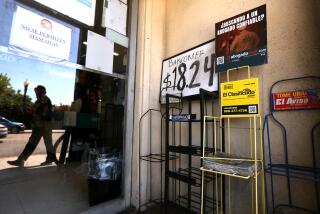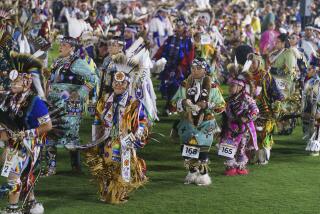Database Tells the Stories of 100,000 Mission Indians
- Share via
Reclaiming a neglected part of California’s past, historians Monday unveiled an immense data bank that for the first time chronicles the lives and deaths of more than 100,000 Indians in the Spanish missions of the 18th and 19th centuries.
In an eight-year effort, researchers at the Huntington Library in San Marino used handwritten records of baptisms, marriages and deaths at 21 Catholic missions and two other sites from between 1769 and 1850 and created a cross-referenced computerized repository that is now open to public access.
The Early California Population Project, its creators hope, will help bring the state’s Spanish colonial and Mexican eras from out of the long shadows cast by the 13 English colonies on the East Coast.
“What we are trying to do here is to say these people have a history, and it’s not a history that can be caricatured,” said the project’s general editor, historian Steven W. Hackel. “It’s a history that emerges from a deep native past and a deep Spanish past and shows how the two came together for better or worse.”
Huntington officials say scholars and amateur genealogists will be able to track, among other things, how many descendants of a Miwok Indian survived into the era of U.S. statehood, how many people died in an earthquake or a measles epidemic, how frequent intermarriage was between Spanish soldiers and Indian women, or how many Indians worked in farming or became skilled artisans.
The database does not offer judgments on the long debates about whether the Franciscans forced Indians into the missions and treated them brutally or whether Father Junipero Serra, founder of the California mission system, deserves to be, as he is now, just one step from sainthood in the Roman Catholic Church.
However, it does document the Franciscans’ obsessions with converting Indians to Catholicism and its bans on polygamy and illegitimacy. And, death by death, it shows an extraordinarily high mortality rate as Indians became exposed to European diseases such as measles, influenza and smallpox.
“People who think the missions were places of cultural genocide and terrible population decline can look at this database, and they’ll see that people came into the missions and died soon after,” said Hackel, a history professor at Oregon State University. “People who want to see something else in the missions can look here too. It also shows tremendous Indian persistence and attempts to maintain their own communities within the missions.”
The public can gain access to the database through an Internet link at https://www.huntington.org. Conducting searches on the site can be complicated at first because of the many choices involved.
The project, which cost $650,000, used records mainly taken from microfilm of the originals. They overwhelmingly concern Indians in the coastal regions from the San Diego to Marin County areas, perhaps as many as half of the Indians within the current state borders. Some Spanish soldiers and Mexican settlers are included through the turbulent times of Mexico’s independence from Spain in 1821 and California U.S. statehood in 1850.
There are some gaps in the documents as the missions declined, the Franciscans were stripped of their authority and Indians revolted. After the San Diego mission was burned down in an insurrection in 1775, the priests re-created the logs from memory, Hackel said.
Still, the Franciscans remained good record-keepers. They assigned numbers to each baptism and carefully noted parents and godparents, village of origin, ethnic background and trades. As a result, many people can be traced with astonishing specifics through life and, with computer links, their progeny.
For example, a 2-day-old Indian boy, given the name Francisco, was baptized Aug. 11, 1786, at Mission San Diego, the project shows. The information links to his marriage at 18 to a woman named Maria Loreta, also 18 (a spinster by that era’s customs) and her death five years later with no children.
Francisco married again the next year to Antonina, who died childless 10 months later. He married a third time, to Thomasa (she was 13 and he was 26) and had a baby girl, Ynes, who died at 6 months. Francisco died April 4, 1817, apparently held in high regard by the Franciscans because he was given a deathbed communion, not just an anointing.
Thomasa married twice more and had 10 more children, two of whom are recorded as dying in infancy.
The causes of deaths in that clan were not given, but other records reveal risks of Western life beyond disease. Some people died from bear and snake attacks and others drowned in wells. The 1812 San Juan Capistrano earthquake killed 39, all buried in the ruins of the mission church.
“It tells us one heck of a lot about the people of California before 1850,” said Robert C. Ritchie, the Huntington’s director of research. “It has an enormous amount of detail that sits below the big story we know: the dying of so many native people along the coast.”
Although surveys of smaller groups of missions were done in the past, none pulled together populations from across what was known as Alta California, scholars say. Plus, no other project on this topic was designed for the average person, not just experts, to navigate.
“The goal is democratic and open access to records that previously were, if not inaccessible, very, very hard to get,” said Hackel, whose 2005 book, “Children of Coyote, Missionaries of Saint Francis,” examined Indian-Spanish relations in that period.
The raw records can be difficult to read, interpret and put into context, he added.
The project involved eye-straining work that took the equivalent of between two and four full-time employees since 1999. Their job was to take hundreds of thousands of bits of information from the microfilm of sometimes damaged and illegible mission books and put them into easy-to-read computer formats.
Anne Marie Reid, the inputting team leader, recalled feeling ill sometimes after long days staring at dark microfilm in Spanish and Latin and entering names and dates into computer logs.
But she said she also gained a feeling of fellowship with the Indians and priests as she recognized their names in various references. “You come to know these people,” she said recently in her small workroom with consoles and screens.
In all, statistics were gleaned on an estimated 120,000 people, including some with incomplete records and some mentioned just once as a parent. Included are about 101,000 baptisms, 28,000 marriages and 71,000 burials at all 21 missions and from the Los Angeles Plaza Church and the Santa Barbara Presidio.
Partly because of the size, the project experienced some delays this summer because of software glitches.
The Huntington has a few original and very valuable mission records, including a page in Serra’s very legible hand about three baptisms on Dec. 1, 1783, at Mission San Luis Obispo. Missions and other Catholic archives hold most of the surviving books but usually allow scholars to see only microfilm copies, some made 50 years ago.
Among the institutions lending microfilm for the project were the Santa Barbara Mission Archive-Library, the archdioceses of San Francisco and Los Angeles, and Santa Clara University. John R. Johnson, curator of anthropology for the Santa Barbara Museum of Natural History, and Randall Milliken, a Davis-based anthropologist and mission expert, helped with planning.
The largest financial support for the project came from the National Endowment for the Humanities ($294,000), the California State Library ($163,000) and the John Randolph Haynes and Dora Haynes Foundation ($110,000).
The Dan Murphy Foundation and the Giles W. and Elise G. Mead Foundation were among other donors.
Anthony Morales, tribal chair and chief of the Gabrieleno/Tongva Band of Mission Indians of San Gabriel, said he thought the project would “really catch the interest of all kinds of people like educators and researchers and just average folks who are interested in their families.”
Some people, he said, will search for evidence of brutality in the mission system such as forced conversions and labor, while others will look for a more positive picture, such as “what did happen after my great-great-grandmother got converted and baptized.”
Robert Senkewicz, a Santa Clara University historian who is an expert on early California, said the accessibility of the database is its “great virtue.”
“It will make genealogists feel like they died and went to heaven,” he said.
More to Read
Sign up for Essential California
The most important California stories and recommendations in your inbox every morning.
You may occasionally receive promotional content from the Los Angeles Times.











